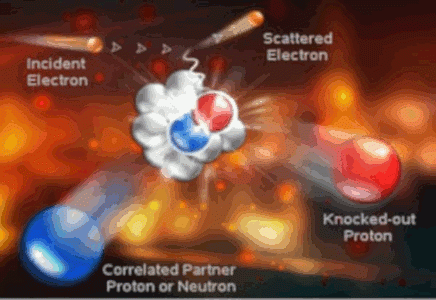Nucleon-Nucleon Short-Range Correlations

Illustration of the 12C(e,e'pN) reaction. The incident electron couples to a nucleon-nucleon pair via a virtual photon. In the final state, the scattered electron is detected along with the knocked-out proton, as well as the correlated partner.
Additional Links
The nucleus can often be approximated as an independent collection of protons and neutrons confined in a volume, but for short periods of time, the nucleons in the nucleus can strongly overlap. This quantum mechanical overlapping, known as a nucleon-nucleon short-range correlation, is a manifestation of the nuclear strong force, which produces not only the long-range attraction that holds matter together, but also the short-range repulsion that keeps it from collapsing.
Direct observation of short-range correlations has been a challenge for nuclear physics, as other phenomena often mask the signal. Cross section ratios of inclusive scattering of heavy nuclei to 3He at Q2>1.4 [GeV/c]2 and as function of Brokjen x have shown scaling regions that have been interpreted as corresponding to two- and three-nucleon correlations [1]. To directly observe high momentum pairs emerging from the nucleus, a triple coincident 12C(e,e'pN) experiment was designed to probe high Q2>1.5 [GeV/c]2, Brokjen x>1 and missing momenta greater than 300 [MeV/c]2.
The experiment found, for these special conditions, that every single knocked-out proton had a correlated partner [2]. As predicted by theorists [3], the correlated nucleon pairs were predominately proton-neutron pairs with only a small fraction of proton-proton pairs. Since the nuclear density of a correlated pair is approximately five times larger than average nuclear matter, these results may give scientists new insight into dense nuclear systems such as neutron stars.
References:
[1] K. S. Egiyan et al., Phys. Rev. C 68 (2003) 014313 and Phys. Rev. Lett. 96 (2006) 082501.
[2] R. Subedi et al., Science 320 (2008) 1476 and R. Shneor et al., Phys. Rev. Lett. 99 (2007) 072501.
[3] M. M. Sargsian et al., Phys. Rev. C 71 (2005) 044615. and R. Schiavilla et al., Phys. Rev. Lett. 98 (2007) 132501

